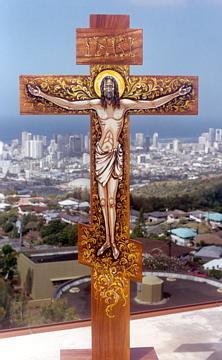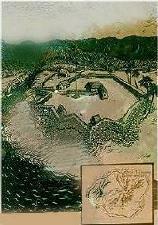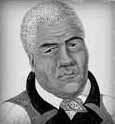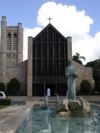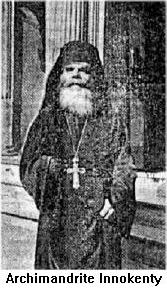Difference between revisions of "Orthodoxy in Hawaii"
(→Rebirth of Orthodoxy: copyedit) |
(general copyedit, moved photo, added intro, added Orthodoxy in America template) |
||
| Line 1: | Line 1: | ||
| − | |||
| − | |||
[[Image:hawaiiorthodox.jpg|right|frame| The Main Altar Cross of the Russian Orthodox Church of Hawaii in Honolulu]] | [[Image:hawaiiorthodox.jpg|right|frame| The Main Altar Cross of the Russian Orthodox Church of Hawaii in Honolulu]] | ||
| + | '''Orthodox Christianity in Hawaii''' has a history beginning with the early Russian missions of the 19th century and continuing to the work of multiple Orthodox churches on the various islands that make up the state. | ||
==History of Hawaiian Orthodoxy== | ==History of Hawaiian Orthodoxy== | ||
| + | {{orthodoxyinamerica}} | ||
=== Christianity in Hawaii === | === Christianity in Hawaii === | ||
| − | The first Christian service held in Hawaii was a [[Church of Russia|Russian Orthodox]] [[Pascha]]l service. Somewhere between 1792 and 1793, while traveling from Far East to what was then Russian America, a Russian trading ship stopped over in the Hawaiian Islands. The Russian Orthodox [[priest]], not wanting to celebrate | + | The first Christian service held in Hawaii was a [[Church of Russia|Russian Orthodox]] [[Pascha]]l service. Somewhere between 1792 and 1793, while traveling from Far East to what was then Russian America, a Russian trading ship stopped over in the Hawaiian Islands. The Russian Orthodox [[priest]], not wanting to celebrate Pascha at sea, instructed the captain to disembark. The captain then told the priest that he feared the "natives" but was then told, "They will not harm us, for we are Orthodox, and we bear the Light of Christ to illumine their hearts." They disembarked and blessed a temporary [[altar]] under a newly built temple made out of palms and bamboo and adorned with a Znammeny icon of the Mother of God and the Christ Child. It was rumored that as they departed the priest left the icon used in the Paschal Liturgy. The ship's priest promised that, "We shall return and baptize these natives to the [[One Holy Catholic and Apostolic Church|One, Holy, Catholic, and Apostolic Church]]." |
=== First Orthodox Chapels === | === First Orthodox Chapels === | ||
| − | [[Image:Fortelizabeth.jpg| | + | [[Image:Fortelizabeth.jpg|left|frame|Russian Fort Elizabeth as it was in 1815 on the Island of Kauai]] |
| − | In 1815, Russians built Hawaii's first | + | In 1815, Russians built Hawaii's first Orthodox church; the Russian Orthodox chapel at [[w:Russian Fort Elizabeth|Fort Elizabeth]]. On the Island of Kaua'i, three Russian forts were built: Fort Alexander, Fort Barclay, and Fort Elizabeth. Fort Alexander also housed a small Orthodox chapel, but Fort Elizabeth was the trading base for the new Russian-American Company in Hawaii. When King Kaumuali'i of Kaua'i ceded his kingdom to King Kamehameha the Great in 1816 following the tsar's refusal to annex Kaua'i due to political troubles in Russia, the forts were also ceded, and the Hawaiian Islands become one unified kingdom. The chapels ultimately fell into disrepair after Calvinist missionaries from the United States landed in 1820 after the death of King Kamehameha I. |
[[Image:kamehameha.jpg|left|frame|Russian Artist's Sketch of King Kamehameha the Great of Hawaii]] | [[Image:kamehameha.jpg|left|frame|Russian Artist's Sketch of King Kamehameha the Great of Hawaii]] | ||
| − | In 1882, the Hawaiian Kingdom sent a diplomatic delegation to St. Petersburg, Russia, to witness the coronation of Tsar Alexander III. The reports of the Hawaiian special envoy to the Russian court, Colonel Curtis 'Iaukea, about the [[liturgy|liturgical]] services were widely published in Hawaiian-language newspapers. Two years later, Tsar Alexander III sent King Kalakaua the Imperial Order of St. [[Alexander | + | In 1882, the Hawaiian Kingdom sent a diplomatic delegation to St. Petersburg, Russia, to witness the coronation of Tsar Alexander III. The reports of the Hawaiian special envoy to the Russian court, Colonel Curtis 'Iaukea, about the [[liturgy|liturgical]] services were widely published in Hawaiian-language newspapers. Two years later, Tsar Alexander III sent King Kalakaua the Imperial Order of St. [[Alexander Nevsky]], the highest Russian award, and established a permanent Russian embassy in Hawaii, along with a very small Orthodox chapel. Subsequently, 200 Ukrainians were imported by American sugar planters. |
In 1893, Queen Lili'uokalani was deposed by U.S. Marines and American sugar plantation owners, who were mostly the children of American Calvinist missionaries, and a provisional government under the protection of the United States was installed. In 1898, Hawaii was incorporated into the United States despite near universal opposition from native Hawaiians. In the early 1900s, the Russian ambassador was recalled, the embassy was moved to a small office, and the Russian chapel was closed. | In 1893, Queen Lili'uokalani was deposed by U.S. Marines and American sugar plantation owners, who were mostly the children of American Calvinist missionaries, and a provisional government under the protection of the United States was installed. In 1898, Hawaii was incorporated into the United States despite near universal opposition from native Hawaiians. In the early 1900s, the Russian ambassador was recalled, the embassy was moved to a small office, and the Russian chapel was closed. | ||
| − | + | St. [[Innocent of Moscow]] also made a brief stop-over in Hawaii during his travels from Asia to Western America. | |
== Rebirth of Orthodoxy == | == Rebirth of Orthodoxy == | ||
[[Image:korchinsky.gif|left|frame|A photo of Fr. Jakob Korchinsky from the Pacific Commercial Advertiser, January 23, 1916]] | [[Image:korchinsky.gif|left|frame|A photo of Fr. Jakob Korchinsky from the Pacific Commercial Advertiser, January 23, 1916]] | ||
| − | On [[November 27]], 1910 ([[Julian Calendar]]), with the blessing of the [[bishop]]s of Vladivostok and in America, the first Russian Orthodox reader services were held by Reader Vasily Pasderin. | + | On [[November 27]], 1910 ([[Julian Calendar|O.S.]], the Feast Day of the Znamenny-[[Kursk Root Icon]] of the Sign of the [[Theotokos|Mother of God]]), with the blessing of the [[bishop]]s of Vladivostok and in America, the first Russian Orthodox [[reader services]] were held by Reader Vasily Pasderin. |
| + | |||
| + | In 1915, at the petition of the Russian Orthodox community to the [[Holy Synod]] in Moscow, a priest was dispatched to Hawaii to pastor the large population of faithful. On [[Christmas]] ([[December 25]], O.S.), Protopresbyter Jakob Korchinsky celebrated the [[Divine Liturgy]] at Saint Andrew's Episcopal Cathedral in Honolulu, and he established permanent liturgical services. Thus Orthodoxy was re-established in Hawaii. | ||
| − | + | [[Image:episcopal.jpg|right|thumb|100px|St. Andrew's Episcopal as it appears today in downtown Honolulu]] | |
| + | Fr. Jakob, a well-known [[missionary]] priest, established churches in Canada, the United States, Alaska, and Australia. He was murdered in [[Odessa]] shortly after the [[w:Russian Orthodox Church#Russian revolution|Bolshevik Revolution]] in Russia, but has not yet been officially recognized as a martyr. | ||
| − | In subsequent years, the Russian Orthodox | + | In subsequent years, the Russian Orthodox church in Hawaii shipped or flew priests to Hawaii to care for the dwindling Orthodox population, becoming part of the [[Russian Orthodox Church Outside Russia]] (ROCOR). [[Archimandrite]] Innokenty Dronov of Hilo, a contemporary of St. [[Jonah of Manchuria]] and St. [[John Maximovitch|John of Shanghai and San Francisco]] and Metropolitan [[Meletius of Harbin]], served the entire Orthodox Christian flock on all the Hawaiian Islands throughout the 1930s and 1940s. Fr. Innokenty had a large following of [[Church of Japan|Japanese Orthodox]] Christians. He frequently returned to the [http://www.wadiocese.com Diocese in San Francisco] to report to Archbishops [[Apollinary (Koshevov) of San Francisco|Apollinary (Koshevov)]] and [[Tikhon (Troitsky) of San Francisco|Tikhon (Troitsky)]] and for medical reasons. He is now purportedly buried on the Big Island of Hawaii. |
[[Image:innokenty.jpg|left|frame|Fr. Innokenty in front of the Old Apostles Episcopal church in Hilo in 1937]] | [[Image:innokenty.jpg|left|frame|Fr. Innokenty in front of the Old Apostles Episcopal church in Hilo in 1937]] | ||
| − | == | + | == Multiple jurisdictions == |
| − | Up until the 1960s, the Russian Orthodox Church was the only Orthodox jurisdiction in the Hawaiian Islands. Following the 1960s, parishes from three | + | Up until the 1960s, the Russian Orthodox Church was the only Orthodox jurisdiction in the Hawaiian Islands. Following the 1960s, parishes from three separate Orthodox jurisdictions established themselves in the Islands: [[Greek Orthodox Archdiocese of America|Greek]], [[Serbian Orthodox Church in the USA and Canada|Serbian]], and [[OCA]]. At one point there were as many as five different Orthodox jurisdictions in the Hawaiian Islands. Despite this multiplicity of jurisdictions, all Orthodox churches in Hawaii are in communion with one another and have friendly relations. (See also: [[Orthodoxy in America]], [[Diaspora]].) |
| − | + | ===The Russian Orthodox Church (ROCOR)=== | |
| − | In the late 1960s, a group of Russian Orthodox Christians parted ways with the local Greek community and joined the Russian Orthodox Church in Hawaii under the Omophorion of Archbishop Anthony of Los Angeles; they formed the St. [[Mark of Ephesus]] Russian Orthodox Mission | + | In the late 1960s, a group of Russian Orthodox Christians parted ways with the local Greek community and joined the Russian Orthodox Church in Hawaii under the Omophorion of Archbishop Anthony of Los Angeles; they formed the St. [[Mark of Ephesus]] Russian Orthodox Mission. In the early 1980s, this mission parish was later re-[[consecrate|consecrated]] under the heavenly protection of the [[Mother of God]] and is now known as the Holy [[Theotokos]] of [[Iveron]] Russian Orthodox Church. In the late 1990s, the cpastor of the Russian Orthodox community, Father Anatole Lyovin, was [[ordination|ordained]] to serve the Orthodox faithful in Hawaii. Currently this parish is without a permanent structure, but there are plans to build the first Russian Orthodox [[church]] in Honolulu. |
| − | Fr. Anatole also oversees the Russian Orthodox mission communities on Kauai and the Big Island of Hawaii. These Russian communities are under the spiritual care of Archbishop [[Kyrill (Dmitrieff) | + | Fr. Anatole also oversees the Russian Orthodox mission communities on Kauai and the Big Island of Hawaii. These Russian communities are under the spiritual care of Archbishop [[Kyrill (Dmitrieff) of San Francisco]] (ROCOR). |
| − | + | ===The Greek Orthodox Church (GOARCH)=== | |
| − | In the mid 1960s, a | + | In the mid 1960s, a Greek Orthodox community established a Greek Orthodox mission under the auspices of the [[Greek Orthodox Archdiocese of America|Greek Archdiocese]]. This community became known as the Ss. [[Constantine the Great|Constantine]] and [[Helen]] Greek Orthodox Church. The current (and temporary) pastor of the Greek Orthodox community in Hawaii is Fr. Demetrius Dogias, who was assigned to the parish in Honolulu in 2007. |
| − | In the | + | In the 1990s, on the Island of Maui, a Greek Orthodox mission was established. This mission is served by clergy of Ss. Constantine and Helen Greek Orthodox Church in Honolulu. These two Greek communities are under the care of Metr. [[Gerasimos (Michaelas) of San Francisco]] (GOARCH). |
| − | + | ===The Serbian Orthodox Church=== | |
| − | In the early 1990s, a Serbian community established an Orthodox mission dedicated to | + | In the early 1990s, a Serbian community established an Orthodox mission dedicated to St. [[Lazar of Serbia|Lazar of Kosovo]]. The Serbian mission later became inactive, and its remaining members joined the local Russian and Greek churches. There has been a recent interest within the Serbian Orthodox community in Hawaii to re-establish this mission. In recent months, visiting clergy (including the Serbian Bishop [[Maxim (Vasilijevic) of Western America]]) have come from the mainland to minister to them. |
| − | |||
| − | + | ===The Antiochian Orthodox Church=== | |
| − | In 2003, the short-lived St. Paul the Apostle Antiochian Orthodox Mission was established in Honolulu at Fort Shafter Army Base. The rector of this mission was Fr. Isaiah Gillette, a chaplain with the military. Following Fr. Isaiah's transfer to Texas, | + | In 2003, the short-lived St. Paul the Apostle [[Antiochian Orthodox Christian Archdiocese of North America|Antiochian Orthodox]] Mission was established in Honolulu at Fort Shafter Army Base. The rector of this mission was Fr. Isaiah Gillette, a chaplain with the military. Following Fr. Isaiah's transfer to Texas, the mission was disbanded. |
| − | + | ===The OCA=== | |
| − | In early 2004, a new Orthodox community under the jurisdiction of the [[OCA]] was established in Kona, Hawaii. Fr. Sergius Naumann served this community for a time until leaving for Alaska. They are currently overseen by | + | [[Image:Bishop Benjamin.jpg|thumb|145px|right|Bishop Benjamin visits the Kona Mission]] |
| + | In early 2004, a new Orthodox community under the jurisdiction of the [[OCA]] was established in Kona, Hawaii. Fr. Sergius Naumann served this community for a time until leaving for Alaska. They are currently overseen by Bp. [[Benjamin (Peterson) of San Francisco]] of the [[Diocese of the West (OCA)|Diocese of the West]] and other clergy from the mainland. This mission is under the supervision of Archpriest George Gray. | ||
| − | == | + | ==Parishes in Hawaii== |
*Holy Theotokos of Iveron Russian Orthodox Church of Hawaii - [http://www.orthodoxhawaii.org Official website] | *Holy Theotokos of Iveron Russian Orthodox Church of Hawaii - [http://www.orthodoxhawaii.org Official website] | ||
*Ss. Constantine and Helen Greek Orthodox Church - [http://www.ssconhelhi.goarch.org Official Website] | *Ss. Constantine and Helen Greek Orthodox Church - [http://www.ssconhelhi.goarch.org Official Website] | ||
| Line 70: | Line 73: | ||
[[Category:Jurisdictions]] | [[Category:Jurisdictions]] | ||
| + | [[Category:Church History|Hawaii]] | ||
Revision as of 13:00, June 1, 2007
Orthodox Christianity in Hawaii has a history beginning with the early Russian missions of the 19th century and continuing to the work of multiple Orthodox churches on the various islands that make up the state.
Contents
History of Hawaiian Orthodoxy
| This article forms part of the series Orthodoxy in America | |
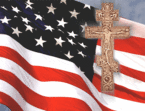
| |
| History | |
| American Orthodox Timeline American Orthodox Bibliography Byzantines on OCA autocephaly Ligonier Meeting ROCOR and OCA | |
| People | |
| Saints - Bishops - Writers | |
| Jurisdictions | |
| Antiochian - Bulgarian OCA - Romanian - Moscow ROCOR - Serbian Ecumenical Patriarchate: | |
| Monasteries | |
| Seminaries | |
| Christ the Saviour Holy Cross Holy Trinity St. Herman's |
St. Tikhon's St. Sava's St. Sophia's St. Vladimir's |
| Organizations | |
| Assembly of Bishops AOI - EOCS - IOCC - OCEC OCF - OCL - OCMC - OCPM - OCLife OISM - OTSA - SCOBA - SOCHA | |
| Groups | |
| Amer. Orthodox Catholic Church Brotherhood of St. Moses the Black Evangelical Orthodox Church Holy Order of MANS/CSB Society of Clerks Secular of St. Basil | |
| Edit this box | |
Christianity in Hawaii
The first Christian service held in Hawaii was a Russian Orthodox Paschal service. Somewhere between 1792 and 1793, while traveling from Far East to what was then Russian America, a Russian trading ship stopped over in the Hawaiian Islands. The Russian Orthodox priest, not wanting to celebrate Pascha at sea, instructed the captain to disembark. The captain then told the priest that he feared the "natives" but was then told, "They will not harm us, for we are Orthodox, and we bear the Light of Christ to illumine their hearts." They disembarked and blessed a temporary altar under a newly built temple made out of palms and bamboo and adorned with a Znammeny icon of the Mother of God and the Christ Child. It was rumored that as they departed the priest left the icon used in the Paschal Liturgy. The ship's priest promised that, "We shall return and baptize these natives to the One, Holy, Catholic, and Apostolic Church."
First Orthodox Chapels
In 1815, Russians built Hawaii's first Orthodox church; the Russian Orthodox chapel at Fort Elizabeth. On the Island of Kaua'i, three Russian forts were built: Fort Alexander, Fort Barclay, and Fort Elizabeth. Fort Alexander also housed a small Orthodox chapel, but Fort Elizabeth was the trading base for the new Russian-American Company in Hawaii. When King Kaumuali'i of Kaua'i ceded his kingdom to King Kamehameha the Great in 1816 following the tsar's refusal to annex Kaua'i due to political troubles in Russia, the forts were also ceded, and the Hawaiian Islands become one unified kingdom. The chapels ultimately fell into disrepair after Calvinist missionaries from the United States landed in 1820 after the death of King Kamehameha I.
In 1882, the Hawaiian Kingdom sent a diplomatic delegation to St. Petersburg, Russia, to witness the coronation of Tsar Alexander III. The reports of the Hawaiian special envoy to the Russian court, Colonel Curtis 'Iaukea, about the liturgical services were widely published in Hawaiian-language newspapers. Two years later, Tsar Alexander III sent King Kalakaua the Imperial Order of St. Alexander Nevsky, the highest Russian award, and established a permanent Russian embassy in Hawaii, along with a very small Orthodox chapel. Subsequently, 200 Ukrainians were imported by American sugar planters.
In 1893, Queen Lili'uokalani was deposed by U.S. Marines and American sugar plantation owners, who were mostly the children of American Calvinist missionaries, and a provisional government under the protection of the United States was installed. In 1898, Hawaii was incorporated into the United States despite near universal opposition from native Hawaiians. In the early 1900s, the Russian ambassador was recalled, the embassy was moved to a small office, and the Russian chapel was closed.
St. Innocent of Moscow also made a brief stop-over in Hawaii during his travels from Asia to Western America.
Rebirth of Orthodoxy
On November 27, 1910 (O.S., the Feast Day of the Znamenny-Kursk Root Icon of the Sign of the Mother of God), with the blessing of the bishops of Vladivostok and in America, the first Russian Orthodox reader services were held by Reader Vasily Pasderin.
In 1915, at the petition of the Russian Orthodox community to the Holy Synod in Moscow, a priest was dispatched to Hawaii to pastor the large population of faithful. On Christmas (December 25, O.S.), Protopresbyter Jakob Korchinsky celebrated the Divine Liturgy at Saint Andrew's Episcopal Cathedral in Honolulu, and he established permanent liturgical services. Thus Orthodoxy was re-established in Hawaii.
Fr. Jakob, a well-known missionary priest, established churches in Canada, the United States, Alaska, and Australia. He was murdered in Odessa shortly after the Bolshevik Revolution in Russia, but has not yet been officially recognized as a martyr.
In subsequent years, the Russian Orthodox church in Hawaii shipped or flew priests to Hawaii to care for the dwindling Orthodox population, becoming part of the Russian Orthodox Church Outside Russia (ROCOR). Archimandrite Innokenty Dronov of Hilo, a contemporary of St. Jonah of Manchuria and St. John of Shanghai and San Francisco and Metropolitan Meletius of Harbin, served the entire Orthodox Christian flock on all the Hawaiian Islands throughout the 1930s and 1940s. Fr. Innokenty had a large following of Japanese Orthodox Christians. He frequently returned to the Diocese in San Francisco to report to Archbishops Apollinary (Koshevov) and Tikhon (Troitsky) and for medical reasons. He is now purportedly buried on the Big Island of Hawaii.
Multiple jurisdictions
Up until the 1960s, the Russian Orthodox Church was the only Orthodox jurisdiction in the Hawaiian Islands. Following the 1960s, parishes from three separate Orthodox jurisdictions established themselves in the Islands: Greek, Serbian, and OCA. At one point there were as many as five different Orthodox jurisdictions in the Hawaiian Islands. Despite this multiplicity of jurisdictions, all Orthodox churches in Hawaii are in communion with one another and have friendly relations. (See also: Orthodoxy in America, Diaspora.)
The Russian Orthodox Church (ROCOR)
In the late 1960s, a group of Russian Orthodox Christians parted ways with the local Greek community and joined the Russian Orthodox Church in Hawaii under the Omophorion of Archbishop Anthony of Los Angeles; they formed the St. Mark of Ephesus Russian Orthodox Mission. In the early 1980s, this mission parish was later re-consecrated under the heavenly protection of the Mother of God and is now known as the Holy Theotokos of Iveron Russian Orthodox Church. In the late 1990s, the cpastor of the Russian Orthodox community, Father Anatole Lyovin, was ordained to serve the Orthodox faithful in Hawaii. Currently this parish is without a permanent structure, but there are plans to build the first Russian Orthodox church in Honolulu.
Fr. Anatole also oversees the Russian Orthodox mission communities on Kauai and the Big Island of Hawaii. These Russian communities are under the spiritual care of Archbishop Kyrill (Dmitrieff) of San Francisco (ROCOR).
The Greek Orthodox Church (GOARCH)
In the mid 1960s, a Greek Orthodox community established a Greek Orthodox mission under the auspices of the Greek Archdiocese. This community became known as the Ss. Constantine and Helen Greek Orthodox Church. The current (and temporary) pastor of the Greek Orthodox community in Hawaii is Fr. Demetrius Dogias, who was assigned to the parish in Honolulu in 2007.
In the 1990s, on the Island of Maui, a Greek Orthodox mission was established. This mission is served by clergy of Ss. Constantine and Helen Greek Orthodox Church in Honolulu. These two Greek communities are under the care of Metr. Gerasimos (Michaelas) of San Francisco (GOARCH).
The Serbian Orthodox Church
In the early 1990s, a Serbian community established an Orthodox mission dedicated to St. Lazar of Kosovo. The Serbian mission later became inactive, and its remaining members joined the local Russian and Greek churches. There has been a recent interest within the Serbian Orthodox community in Hawaii to re-establish this mission. In recent months, visiting clergy (including the Serbian Bishop Maxim (Vasilijevic) of Western America) have come from the mainland to minister to them.
The Antiochian Orthodox Church
In 2003, the short-lived St. Paul the Apostle Antiochian Orthodox Mission was established in Honolulu at Fort Shafter Army Base. The rector of this mission was Fr. Isaiah Gillette, a chaplain with the military. Following Fr. Isaiah's transfer to Texas, the mission was disbanded.
The OCA
In early 2004, a new Orthodox community under the jurisdiction of the OCA was established in Kona, Hawaii. Fr. Sergius Naumann served this community for a time until leaving for Alaska. They are currently overseen by Bp. Benjamin (Peterson) of San Francisco of the Diocese of the West and other clergy from the mainland. This mission is under the supervision of Archpriest George Gray.
Parishes in Hawaii
- Holy Theotokos of Iveron Russian Orthodox Church of Hawaii - Official website
- Ss. Constantine and Helen Greek Orthodox Church - Official Website
- St. Lazar Serbian Orthodox Mission Parish - News site (No Official Website)
- Maui Greek Orthodox Mission Parish - Official Website
- OCA Mission in Kona - Official website
See also
External links
- Orthodox Christianity in the Hawaiian Islands
- A Yahoogroup dedicated to Orthodox Christianity in Hawaii
- Wikipedia:Russian Fort Elizabeth
Sources
- Archimandrite Avgustin (Nikitin); "Gavraiskie ostrova i Rossiia (Obzor tserkovnykh sviazei i kontaktov" - (Saint-Petersburg; Minneapolis 2002)
